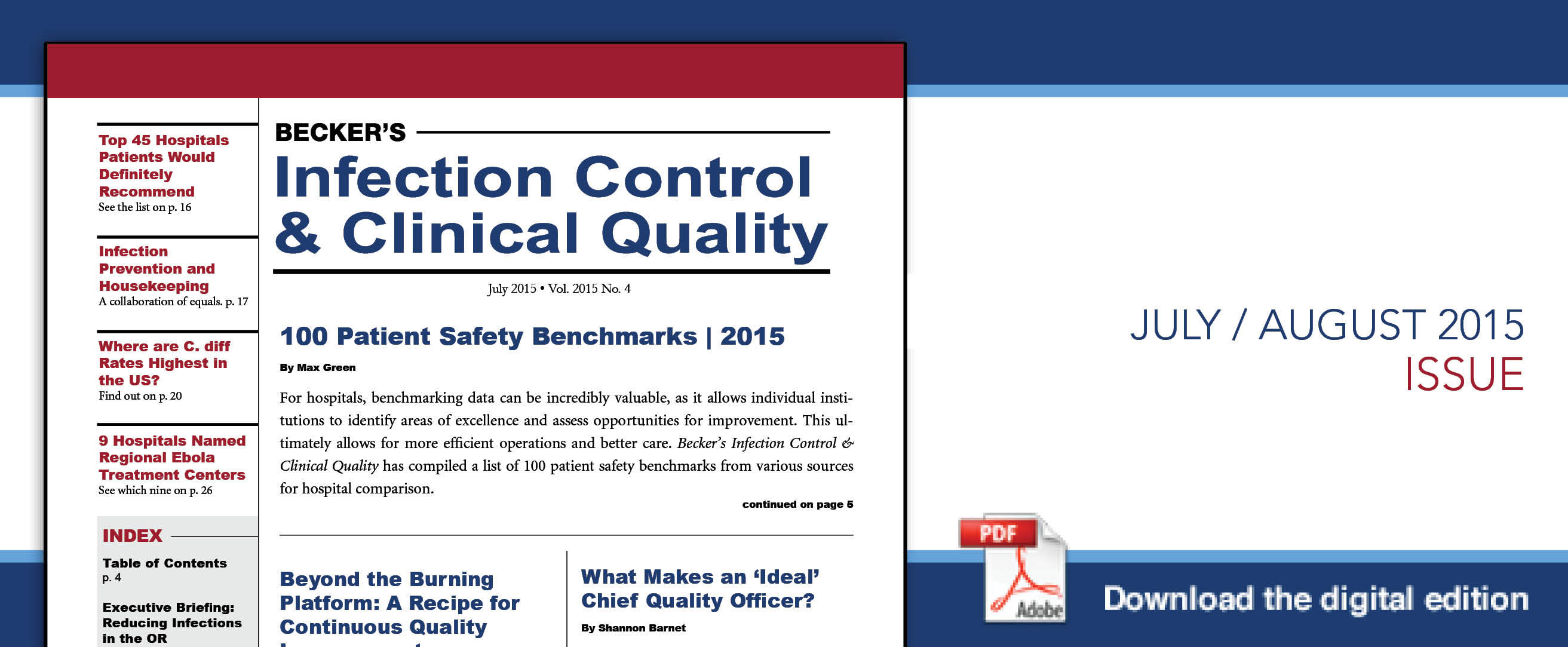On the Cover
|
|
100 Patient Safety Benchmarks | 2015 |
|
|
Beyond the Burning Platform: A Recipe for Continuous Quality Improvement |
 |
What Makes an ‘Ideal’ Chief Quality Officer? |
Executive Briefing: Reducing Infections in the OR
How Improving Sterile Supply Management in the OR can Reduce Infections and Readmissionsand Readmissions
Improving sterile supply management is one way hospitals can reduce the risk of infections and infection-related readmissions for their patients. Click here to Continue >>
Quality Improvement
Are Patient Satisfaction Surveys Doing More Harm Than Good?
Though the intention of patient satisfaction surveys may be altruistic, the focus on patient satisfaction and the surveys designed to measure it could actually lead to a decrease in care quality and an increase in costs, according to recent report from The Hastings Center. Click here to Continue >>
New Online Benchmarking Engine Allows Hospitals to Compare Themselves to PeersPeers
A newly launched online benchmarking engine pulls public data for 4,813 hospitals from CMS’ Hospital Compare website and allows for comparison of hospitals against their peers. Click here to Continue >>
Quality Improvement Efforts Reduce Malpractice Claims, Researchers Find
Improving care quality inside a hospital may prevent malpractice lawsuits just as effectively as laws that limit patients’ ability to win multimillion-dollar judgments for pain and suffering, according to a study published in the American Journal of Medical Quality. Click here to Continue >>
Don’t Wait for Chance: 5 Steps to Purposefully Make Innovative Ideas Work
In a recent blog post for Johns Hopkins’ Armstrong Institute, health services researcher Jill Marsteller, PhD, outlines steps that care teams can take to plan for success when designing quality improvement projects, in order to better understand why an idea succeeds or falls short, and how to effectively repeat it. Click here to Continue >>
https://www.beckershospitalreview.com/quality/don-t-wait-for-chance-5-steps-to-purposefully-make-innovative-ideas-work.html
‘More Hands on Deck, More Often’ may not Improve Quality of Care, Study Suggests
Researchers from the Penn State Hershey Medical Center in Hershey, Pa.., have reported that the implementation of on-site overnight supervision from attending-level physicians, has had no significant impact on clinical outcomes. Click here to Continue >>
Top 45 Hospitals Patients Would ‘Definitely’ Recommend
The following hospitals have the highest proportion of patients who reported yes, they would definitely recommend the hospital, according to their HCAHPS survey results. Click here to Continue >>
Infection Prevention & Control
Infection Prevention and Housekeeping: A Collaboration of Equals
The goals, duties and responsibilities of infection prevention don’t solely reside with infection preventions and clinicians focused on quality initiatives. Click here to Continue >>
Presurgical MRSA Screening Can Help Decrease SSIs, Study Finds
A presurgical intervention that includes screening for Staphylococcus aureus and administering antibiotics based on those screening results was associated with a reduction in S. aureus surgical site infections, according to a study published in JAMA. Click here to Continue >>
SSI Risk Factors: 3 Main Categories
A report from the Centers for Disease Control and Prevention deemed surgical site infections as the most common healthcare-associated infection, accounting for 31 percent of all HAIs among hospitalized patients. Click here to Continue >>
As Temperatures Rise in the Summer, So Do Common SSIs
Common surgical site infections increase in frequency during the summer months, according to recent research published in Infection Control & Hospital Epidemiology. Click here to Continue >>
Physicians, Nurses Disagree on When to Test for C. diff: 11 Risk Factors
Physicians and nurses don’t seem to agree on which risk factors are considered most important when determining whether or not to test patients for Clostridium difficile, according to a study published in the American Journal of Infection Control. Click here to Continue >>
Where are C. diff Rates Highest in the US?
Over the last 10 years, rates of Clostridium difficile infections were highest in the Northeast region of the U.S., according to a study in the American Journal of Infection Control. Click here to Continue >>
Hand Hygiene
Does Product Placement in the ED Influence Hand Hygiene Performance? 6 Study Findings6 Study Findings
A lack of standardization in how hand hygiene-related solutions are arranged at hospital emergency department washbasins may have an effect on performance, according to a study published in the American Journal of Infection Control. Click here to Continue >>
1 in 4 Hospitals Need to Improve Hand Hygiene Practices, Says Leapfrog: 5 Report Findings
Overall, hospitals have been improving hand hygiene practices, but in 2014, one in four still have not implemented all the safe practices and policies recommended for proper hand hygiene, according to a new report by The Leapfrog Group. Click here to Continue >>
Which States’ Hospitals Have the Best, Worst Hand Hygiene Practices?
Although hospitals in the U.S. have improved hand hygiene overall, the level of adoption of hand hygiene safe practices varies significantly from state to state, according to a new report by The Leapfrog Group. Click here to Continue >>
Gamification Yields ‘Significant Improvement’ in Nurse Hand Hygiene Compliance
Using game thinking and mechanics in a non-game context, such as in a hospital or at a patient’s bedside, may be a way to measurably improve hand hygiene compliance, according to a study published in Antimicrobial Resistance & Infection Control. Click here to Continue >>
Automated Training System Improves Hand Hygiene Technique, but Not Compliance
Healthcare workers improved their hand-washing technique by using an automated hand hygiene training system in one study published in the American Journal of Infection Control. Click here to Continue >>
9 Hospitals Named Regional Ebola, Other Special Pathogen Treatment Centers
HHS has named nine health departments and associated partner hospitals as regional treatment centers for patients with Ebola or other severe, highly infectious diseases. Click here to Continue >>
Hand Hygiene
11 Patient Safety Tools Published in 2015
With root cause analysis guidelines, hand hygiene posters, an emergency drill toolkit and a catheter-associated urinary tract infection prevention checklist, Becker’s Infection Control & Clinical Quality has providers covered with an array of patient safety tools. Click here to Continue >>
UV Light Disinfection: Combat 4 Misconceptions With 1 Step
The concept of using ultraviolet light to disinfect isn’t necessarily a new one, but it has gained more attention in recent years, thanks to the push for transparency around infection rates and the financial penalties attached to healthcare-acquired infections and readmissions. Click here to Continue >>
Hospital & Health System CMO, CNO and Chief Quality Officer Moves



